“As the woods are the same, the trees standing in their places, the rocks and the earth… they are always different too, as lights and shadows and seasons and moods pass through them.” Emily Carr
Trees are an endless source of inspiration for me. So many unique combinations of color, light, shadow, form, and other elements (Emily Carr put it well in the quote above). In this post, I provide guidance on how to paint them. I cover:
- Idealized Views
- Simplification
- Purpose
- Color and Light
- Brushwork
- Style and Theme
- Composition
- Nature Is Not Perfect
- Different Mediums
- Step by Step Guide
- Additional Readings
- Want to Learn More?
- Thanks for Reading!

(Before diving into this post, make sure to pick up a copy of my free Landscape Painting Starter Kit.)
Idealized Views
First things first, you must break free of any idealized views you have about trees. That is, what you think a typical tree looks like.
Take a moment to shut your eyes and picture a tree in your mind. What do you see? That tree is not based on reality but rather on the ideas and experiences you have had with trees throughout your life.
For me, and many others I imagine, I see a tree with rich umber wood and luscious green leaves. Some trees look like that, but not all!
These idealized views may seem harmless, but they can work behind the scenes to bias our decisions and paint things that are not actually there. I see it all the time in beginner paintings-they are unsure about the color of the leaves, so they default to green, even if the leaves are warm yellows and oranges.
Leaves are not always green. Wood is not always brown. The sky is not always blue.
Be careful about letting your idealized views dominate how you paint. Paint the tree as you see it.
I will show you what I mean using the following reference photo:

The trees in the foreground are dark and underexposed in the photo. Because it is hard to make out any color, my mind defaults to green and brown. It seems the more ambiguous the colors, the more my idealized views take over. Regarding the trees in the background, beginner painters would be prone to overusing green and underusing yellow and orange.
Simplification
A tree is a complex arrangement of shapes, lines, colors, and other elements. You must learn how to simplify this information to make any sense of it and paint a coherent picture. Even realists like Ivan Shishkin simplified to some extent.
If you could only see basic color shapes, what would the tree look like?
For example, take this reference photo:

This is a complex scene, with countless leaves, branches, shadows, highlights, accents, and colors. Not long ago, I would have put this in the “too hard” basket as my untrained eyes would have been overwhelmed by information. But now, I can tune out the noise and narrow down on the important details.
To give you an idea of what I see, below is the start of a recent study. Nothing more than basic color shapes. It took me about 10 minutes to get to this stage. Yet, even with such primitive detail, there is a quality of realism to it. That is the beauty of narrowing down on the important details and getting them right.

Below is the end result. Keep in mind this is just a small study done in preparation for a larger work (to be revealed shortly, along with progress shots).

I have also been playing around with filters in Photoshop to simplify the noise without picking up a brush (see the two examples below). But this is a matter for a separate post.


Once you see the tree in terms of basic color shapes, the rest is much easier. As long as you stay true to these basic elements, your tree will end up looking somewhat realistic. The amount of detail you use from there is up to you. If you enjoy getting lost in the detail, by all means, paint every leaf and branch. But you do not have to.
Here are some questions to help pull key details from the sea of information:
- What is the lightest light/darkest dark?
- What is positive/negative space?
- What is the hardest edge? (The softest edge is, by nature, difficult to spot).
- What is the focal point?
- What is the most saturated color?
If you want more examples of simplification, check out the work of Sir Arthur Streeton. He was a master of it. His paintings appear fresh and spontaneous, yet there is a remarkable sense of realism. In the painting below, notice how he intricately rendered a few trees in the bottom right. This almost fools you into thinking the rest of the painting is equally detailed.

Purpose
The tree’s purpose will influence how you paint it. A feature tree requires more attention than a background tree. Sounds obvious, but many aspiring artists overlook this idea.
Take Oak on the River Bank by Isaac Levitan (below). The tree in the center is the focus and Levitan painted it accordingly. Subtle color changes, light and shadow patterns, a sense of form, and rendering of individual branches and leaves.

In my painting below, the amber tree is the focus and therefore required more detail and color variance. The other trees in the painting are really just two-value shapes; no mid-tones, no intricate branches, no subtle color changes.

In Claude Monet’s painting below, notice the varying level of detail on the trees. The closer the trees, the more detailed they are.
Also, look at the tall trees shooting up into the sky. The contrast between these trees and the sky (dark green against light blue) is much sharper than the contrast between one tree and others (green against green). Areas of sharp contrast stand out and require more attention, hence the intricate linework and rendering of individual leaves.

Color and Light
“If you see a tree as blue, then make it blue.” Paul Gauguin
There is no color recipe or formula for painting trees. But I can give you some general tips:
- Most of your color questions can be answered by the light. What is the light source? How strong is it? Where is it coming from? What color temperature is it? Is it direct or diffused by clouds?
- What are the lightest, darkest, most saturated, warmest, and coolest colors?
- Pay close attention to changes in color temperature. Are the lights warm compared to the darks?

- Broken color can give the illusion of detail. Refer to Camille Pissarro’s Hyde Park, London:

- Do not try to capture every subtle change in lightness. Simplify the value structure.
- Ensure you have enough color variance. Again, leaves are not always green! Take advantage of yellows, reds, oranges, blues…

- For greens, I often start with viridian and add yellow to make it warmer or blue to make it cooler.

- To paint lighter colors, be careful about adding pure white. Pure white makes colors lighter, weaker, and cooler; this can work against you when painting landscapes. Consider using yellow to lighten your colors.
Brushwork
I generally try to match the nature of my brushwork to the nature of the subject.
Is the bark rough and textured? Use rough and textured brushwork. Or even a palette knife.
Are the leaves delicate? Use delicate brushwork.
Are the leaves and branches dense? Use solid brushwork or layers of broken color.
As for what brushes and tools I use: whatever gets the job done. There are no rules. In my tree study shown earlier in this post (Tree in Perspective), I used filberts, flats, rounds, a palette knife, the tip of my finger, my fingernail, and paper towels.
The tools are there to help get the job done, not limit you in any way. Do not default to the fan brush whenever you need to paint a leaf.
To see what I mean, I suggest you check out Australian artist Ken Knight. Here is a video of him painting. A perfect example of using anything to get the desired result.
Style and Theme
You need to consider the overall style and theme of your painting. Consistency is key. It does not matter how well you paint a tree, or anything for that matter, if it does not fit with the rest of the painting.
Vincent van Gogh took a stylized approach, using bold outlines and directional brushwork to reiterate the contours of the trees.
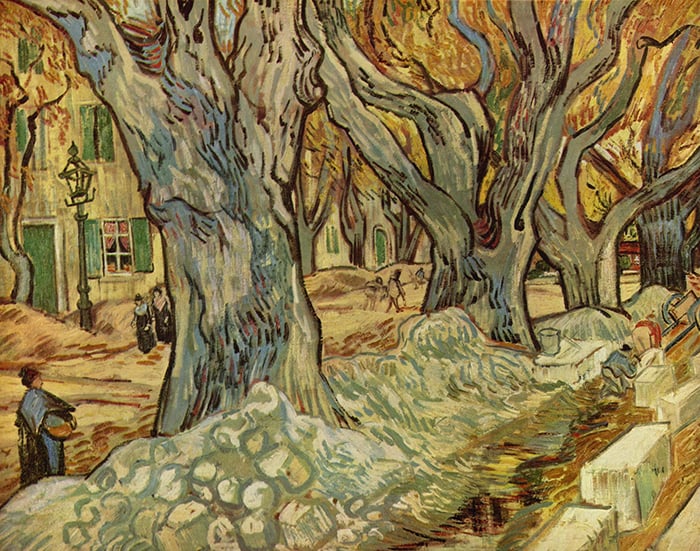
Monet often used rough brushwork and broken color to weave the trees in with the rest of the painting. The challenge with this approach is retaining a sense of form and realism.

Ivan Shishkin’s work is remarkably detailed. Therefore, it made sense for him to paint individual leaves and tiny branches.

Composition
Trees are a fantastic composition tool, particularly in terms of space, balance, and pattern.
Below are some examples, starting with John Singer Sargent’s Olive Trees on Corfu. Notice the dance between positive and negative space. Positive space being space taken up by objects and things (the trees, buildings, and foreground); negative space being the space in between objects and things (the sky and mountains). There is also a secondary level of contrast, with the positive space being dark and the negative space being light.

Here is another example of using trees to create an interesting dance between positive and negative space:
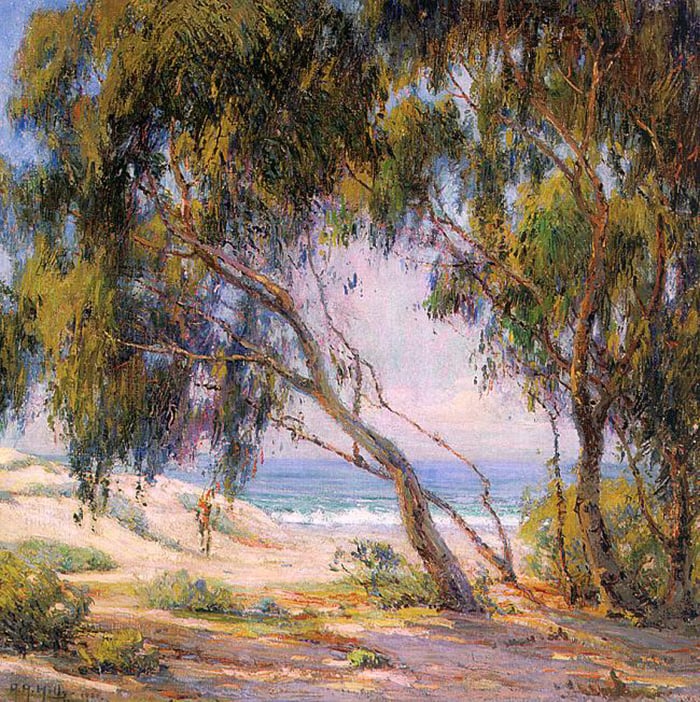
In George Clausen’s The Cherry Orchard, the positive and negative space is woven together by the branches, leaves, and flowers.

Monet often used trees to create a sense of rhythm (refer to the two paintings below).
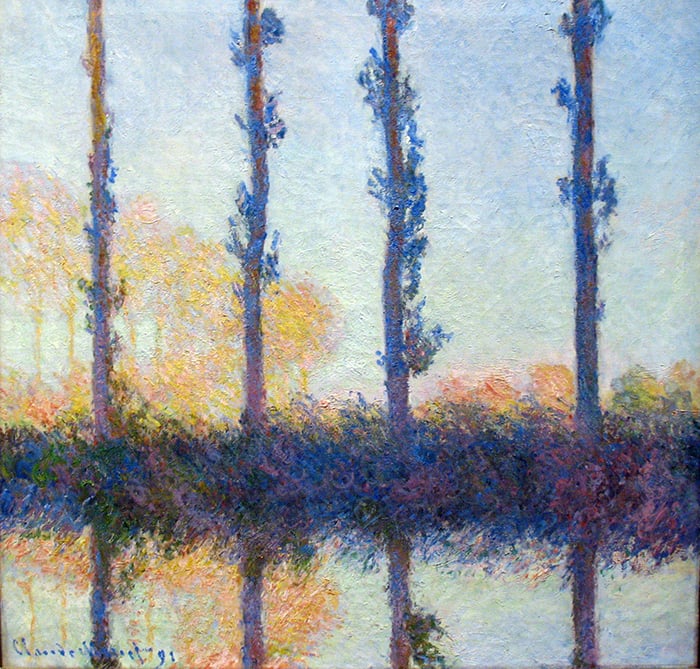
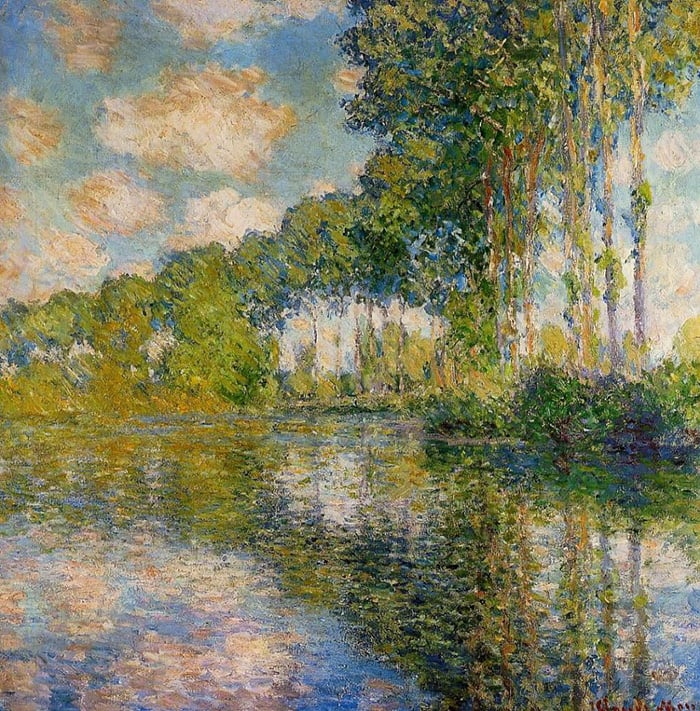
From afar, large numbers of trees unite into solid shapes that can anchor your composition. Refer to Pine Forest below. Hundreds of trees viewed from a distance appear to form a relatively solid shape.

Trees allow you to explore changes in form, contours, and perspective. In Oak, Lit by the Sun (below), the tree and its branches shoot up, down, forward, and back in perspective. This is reiterated by the shadows and contours.

You can use trees to explore extreme perspective points, like looking upward from the foot of a tree (refer to the painting below).

Trees often create interesting light and shadow patterns from light bursting through gaps in the canopy. This is known as dappled light. A common theme in many of Isaac Levitan’s paintings, like the two below.


Nature Is Not Perfect
“If a painting of a tree was only the exact representation of the original, so that it looked just like the tree, there would be no reason for making it; we might as well look at the tree itself. But the painting, if it is of the right sort, gives something that neither a photograph nor a view of the tree conveys. It emphasizes something of character, quality, individuality. We are not lost in looking at thorns and defects; we catch a vision of the grandeur and beauty of a king of the forest.” Calvin Coolidge
Nature is a forgiving subject to paint. No one will notice subtle departures from the subject-an extra tree branch, fewer leaves, a missing tree in the background.
You are not afforded this flexibility in portrait or still life painting. People will notice if you paint the nose wrong.

Different Mediums
I paint in oils, but the information in this post can be applied to any medium. The techniques change, but the principles are the same.
Also, different mediums allow you to capture different sides of the same subject.
Watercolors: untamed, intricate, and transient.

Pencil or pen: perfect for linework and contour drawing.

Oils: thick, textured, dramatic, and versatile.

Step by Step Guide
So far, I have covered high-level principles for painting trees. But I understand some of you are looking for more of a step-by-step guide. So here is mine:
- Indicate the general positioning, size, and shape of the tree. This may be a basic sketch, color stain, or negative painting (lifting paint from the canvas with a cloth or rag).
- Capture the important lights and darks.
- Block in any leaf masses.
- Refine what is on the canvas.
- Add intricate details (individual branches, leaves, highlights, and dark accents).
Keep in mind that what works for me, might not work for you. You may also want to check out my “On The Easel” posts to see my painting approach in action.
Additional Readings
How to Paint This New Zealand Landscape Scene
How to Simplify a Complex Scene

Want to Learn More?
You might be interested in my Painting Academy course. I’ll walk you through the time-tested fundamentals of painting. It’s perfect for absolute beginner to intermediate painters.
Thanks for Reading!
I appreciate you taking the time to read this post and I hope you found it helpful. Feel free to share it with friends.
Happy painting!
Dan Scott

Draw Paint Academy

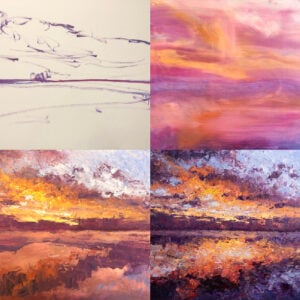





Fabulous information . Thank you
Dear Dan I want to study painting on line and willing to pay. Can you help me?
I took his landscape class, just excellent! There is so much information and personal feedback, recommend without reservation.
What fantastic information to anyone fascinated by trees as I am- very very helpful.
Many thanks.
I visited your country 20 years ago – beautiful scenery
Excellent, just what I have been looking for,( how to paint trees) I worked in Foresty for the Gov’t and grown up in Northern Ontario woods.
You have sent some wonderful information that I find useful and am sure others feel the same.
Thank you
Rip
Oh My Gosh, this took my breath away, a fabulous presentation, Thank you so much,
i am in love with trees and it is my hearts desire to be able to paint beautiful amazingly wonderful trees.
a Bow
Very useful information. Thank you
Thank you for your helpful posts – introducing me to some fabulous artists here – and providing inspiration to pick up the paintbrush and get on with some painting. Trees are difficult when they exist in quantity in the landscapes of Scotland for example – I find they tend to end up looking like blobs or great lumps of paint!
Thank you for this lesson on painting/observing trees. Excellent examples.
Regards
Great post! I am from the Caribbean and would love to hear about coconut and palm trees!
Extremely useful, thank you very much
Your research and explanation on and about trees is always intriguing. I love to paint trees – even those that come from my thoughts and feelings. So much fun. Thanks for all the research you present!
Hi Dan,
Thank you!
I was constantly looking for and longing for such a guidance.
My best wishes,
Lujza
Oh My Goodness! Thank you so much for ‘How To Paint Trees’!. I love it and appreciate all your knowledge being shared! I not only sent the article to my desk top but I printed it out so the info will be near where I am painting so I can refer to it when I need your direction/talent. Thank you again! I really needed that guide!
Dan, thank you for this post, I’ve been stuck on a painting for several days because I wasn’t satisfied with my tree interpretation. I started to do some research and as if through telepathy up came your excellent And very helpful post. It’s also wonderful how you introduce us to some fabulous artists, it’s very much appreciated.
I greatly appreciate the time and effort you put forth and sharing your thoughts and knowledge from your experience.
Your suggestions on trees are very helpful as I used to find them difficult to paint because I was painting a tree and out of shape! Once I no longer thought of trees, as you pointed out it became much easier.
I also appreciate your use of other artists as examples, which introduces new and wonderful artists of whom I had not heard !
Very useful information and interesting reading.
Did you really just send me a post about painting trees without a John F. Carlson Image ?
how could you ?
Dan,
It’s very generous and kind of you to share so much helpful guidance for free during this pandemic. I have been painting individual flowers in watercolour recently, and you are inspiring me to experiment with trees too. Thank you.
Thank you for sharing all of this great information.
I just started painting after decades of not doing anything at all.
Loving it!
Wow.
Thanks so much
These are deep and simplified tips.
The pictures are quite resourceful.
I’m surrounded by trees…I’ve got to learn to draw them!
What an informative and inspirational post. I have not touched my paints since this pandemic hit. You have given me the nudge I need to release months of anxiety and just get on with it! Thank you, Dan.
Hi,
I’m would love to take this course but would have to around the end of May. If you could email me the course, I would hav it saved for then.mthank you so much!
Hi Cheryl. I will send you an email about your comment. Chontele
Thanks. Just what I needed.
Thanks for sharing Dan. Great article packed with fine examples and your insight into painting trees from many of the best painters.
I believe your generosity is deeply appreciated by myself and many of your subscribers.
Please keep it coming or we can become lost in the forest of greenery!
Truly inspirational. I’m going out looking for trees to sketch and paint. Thank you Dan
How caring and generous your willingness to share your expertise!
Thank you so much.
This was organized so well and l love your historical presentation as a back-up for your instruction.
I both paint and teach people of all ages and this is a wonderful approach . You are the best !
Thank you Dan for a wonderful, informative instruction about painting trees. Living in West Virginia, trees dominate and it is difficult to figure out where to begin. This was very helpful. The examples of other artists and your guidance helps tremendously.
Thank you for your lessons. So encouraging…some days I get discouraged or actually more overwhelmed and I found your comments and instruction very calming and helpful.
How wonderful your posts are! Thank you Dan – I learn such a lot & it is really helpful to be exposed to a diverse range of artists & technique tips. Much appreciated
The range of information and concepts is very helpful for me, and to think more laterally has been very worthwhile adventure. your guidance is always well appreciated and I learn something new with each one. Thanks Dan very much.
Thank you Dan for sharing these wonderful information. Thank you for introducing me to other famous artists such as Ivan Shishkin, Isaac Levitan and John Constable whom I have never heard before. I feel very inspired and motivated now.
Dan I have problems seeing the right colors in streams and reflections. Is there a lesson or course that would apply to those two things that would help us?
I love taking photos of trees when we drive in the countrysides and in our walks. I will try to use these photos to execute the tips you mentioned above. I take inspiration from your teachings.
I always have to remember that SIMPLE ISNT ALWAYS EASY. Your instructions r suggestions to maintain personal style…always helpful and informative. They create a passion to PAINT. THANKS P.
Ditto! To all of the above comments! What a treasure trove you are, and thank you from the bottom of my heart! I love everything you share.
Thank you for the detailed and structured guide. Painting trees has always been my nightmare and that’s why I have only done less than five landscapes. After reading this guide, I feel like regaining some confidence to give it more tries. Thank you so much for sharing!
Very helpful.
Being beginner loved the entire chapter. Still I get lost out when encountering with temperature,positive space etc.
Please advise me on the above subject matter so that I can have better understanding. Thanks and warm regards.
Hi Dan, thanks for the lesson on trees! It was very informative and full of great examples! I think “sky holes” are also very important to painting trees. Appreciate your encouragement, as always, you are generous to us fellow artists!
We stand on shoulders of giants. wow…..
Thanks Dan
I really enjoyed this lesson on trees. I have found a new artist, Ivan Shishkin! I really like his work! Thank you Dan!
I really enjoy you and your painting information.
I really enjoy you and your painting information. It has
helped me in my art journey.
Just in time! Thank you, I have been thinking about colors and shades and the richness they give in landscape paintings. Painting is about the continuity of learning new ways and imagination. A great painting is never perfect and imperfections make great paintings.
Dear Dan,
thank you so much for sharing this great information.
I do have a great deal of trouble with trees so hope to apply your formula to my attempts at trees.
Thank you for the trees. I tend to want to detail every little branch and leaf. This helps!
Dear Dan,
I’m going crazy looking at your sharing about trees. Do I need that information.
Dan you are the best,
Thanks so much for all the information,
Yolande
What a wonderful post! I really appreciate all of the helpful guidance you generously provide your readers. I am new to painting (watercolors) and look forward to your messages! (PS: Would also love any guidance you have related to painting palm trees.)
I would also love some about painting Coconut trees as well please . I am a complete novice to this is painting ! It’s a desire lockdown has brought me ! Can’t wait to get off the mark as I am set to go !
Dear Dan Another extraordinary example of the incredible amount of work and information you are sharing with us. Brilliant! Thanks so much and I honestly don’t know how you have time to do anything other than create all these amazing posts jam-packed full of information. You are truly a one-man art school providing much more detailed, step by step, information and tips than I ever learned in art school or any art course I’ve taken. I’m currently taking your Creativity Kickstart 30 days course and it’s FABULOUS. big hugs, Lucy
Very good way of simplifying a complex idea. I learned a lot!
Thanks so much for the information. It’s enormously helpful!
Dan,
Thank you! For sharing your wisdom and perspectives.
Your written critiques are as profound and amazing as the art you cite.
Cheers!
David
Excellent! You gave good information and many examples. Thank you, Dan!
-Liz
Thanks so much for this lesson, Dan. As always, your descriptions and explanations are valuable, clear, and articulate. Just in time for painting en plein air in the island forests here on the west coast of Canada!
I was looking on line last night to get information on how to paint trees, what a coincidence! Thank you so much for sharing this amazing in-depth information Dan.
Hi Dan,
I can say just thankyou,thankyou and thankyou.i could not stop reading !! There is so much information, teaching and tips I just cant wait to get on with painting trees as I love to have trees in my most of my landscapes. i am a big follower of blogs and teaching material.
Steven. Cape Town, South Africa
Muchas gracias muy buena informacion
Hi Dan,
I loved your wonderful article. So detailed and informative. And your two painting are great!
Dan Scott, Tree in Perspective, 2020
Dan Scott, New Zealand, Amber Tree, 2019
Very inspiring.
Many thanks.
Roger Smith
As usual you are looking into the subject and offer a multitude of ideas and tips! Yes trees are i nteresting To paint and not easy in addition to creating the green, the focal point and the atmosphere. Thank you for opening a space in the forest!
I am very impressed by your “Amber Tree”. Thank you for the post, very helpful.
Thank you for this informative and comparisons it was very helpful.
I like it included a practice part.
Thank you Dan, I just love your informative posts and learn so much, so glad you keep them coming.
Kind regards
Laurel
Dear Dan Scott,
Thanks for showing me many types of trees drawing. I learn a lot from you. I like your style of drawing too.
Thank you sir .You gave so important tips and your teaching techniques are so good.
Excelent and objective lesson! Thanks.
Brilliant – I love these lessons. You have the wisdom of a master. Thanks
Your posts always remind me why I was not allowed to take studio art classes in high school and college without also taking art history. I thought it was a horrible waste of time in my mid-spent youth. Your examples are so wonderfully illuminating and helpful. Makes me wish I could go back and stay awake through those 8AM classes!
Very fine article. Thanks for your time and effort. I’ll save this one to read again and again.
Streeton is a dream of a painter.
Wow. There’s a year’s worth of good instruction in here. Thank you.
Btw, I really like your New Zealand tree painting, one of my 3 favorites in this email, and maybe my favorite of yours so far.
A wonderful explanation with important references. Thank you!
I found your information on trees so helpful and informative. For many years I’ve been painting still life and recently started to paint landscapes. I was trying to paint every leaf and was using a lot of white. My work was looking flat. So I’ve learned a lot from you this morning. Dying to get back to easel this morning
Really appreciate your taking the time to post such a comprehensive guide to painting trees. This will help me immensely as I go forward with painting. Thanks a million!
Thank you so much for a amazing presentation!
Gracias muy buenas, recomendaciones
Dear Dan,
Thanks so much.
I love reading these enormously powerful and informative email blogs from you.
I have recently started painting again (Used to do some basic art during my teenage years) with acrylics and your tips are helping me massively.
Not perfect yet but improving each time I am painting.
I have just finished painting a copy of David Stribbling’s African Elephant painting as a practice to understand the colour variance, light and temperature.
Would love to get feedback on my mistakes if possible if I can send it over to you.
Thinking of subscribing to your Paint academy course.
Thank you so much
Kind Regards
Yash
I am so grateful that I still receive your posts even though I did not sign up for your course. Your instruction is so easy to understand and backing up your instruction with great artists’ works for examples is educational and enjoyable. I love your posts and I am learning so much, thank you.
Thank you so much!
Thanks Dan. Very inspiring. Just need to get my paints out and create.
I love this! Thanks so much!
So pleased to have discovered your work and your guidance. I was struggling to complete an autumn scene in a woodland and this information has helped me indefinitely. Already my painting has begun to see structure and depth, whereas before it looked very flat and uninspiring. I can’t wait to finish it and see the results, again many thanks Dan
This is a great post! I am so inspired by tree but they can surely be intimidating to paint so this was very helpful. Can I ask what filters you used in photoshop of that tree in those side by side photos towards the beginning of the post? I am playing with photoshop myself and the filter on the photo on the right would be really helpful!
Thanks Laura! To be honest, I can’t remember. I was just fiddling myself with different filters. Dan
Le filtre photoshop utilisé sur l!mage de droite est” filtre découpage”
Outstanding collection.
I like it very much
Fabulous explanation, I enjoyed reading thankyou
Your presentations, instructions, and tips are so useful! Continue with the great work. You have been helping so many people find their “artistic” inclinations while home-bound due to the pandemic.
Is there a hardback book I can purchase by the person who wrote this online version, or by other authors that cover the same material?
Thank you for this valuable lesson on trees. I am about to start a painting of birch trees and your information will make it easier to choose the composition and which parts to emphasize.